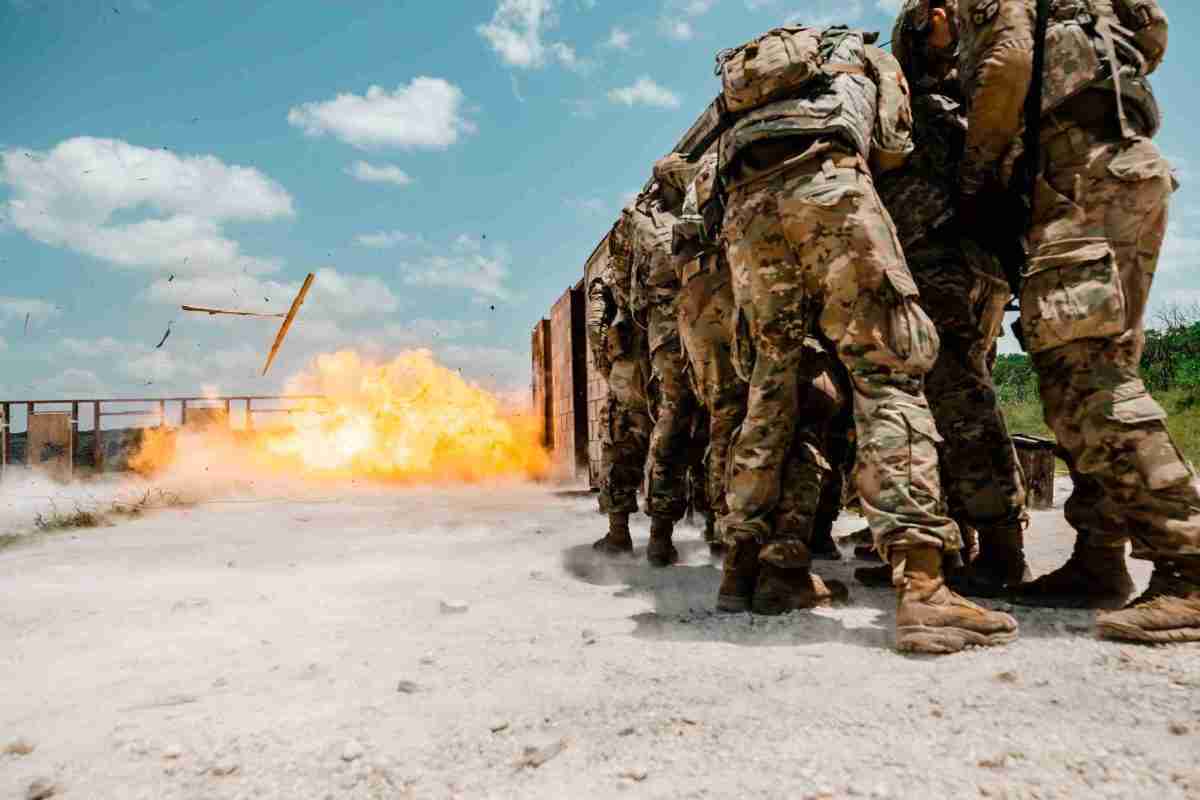
Shrapnel injuries can have hidden dangers affecting military veterans long after their service. In this article, we will explore shrapnel injuries, shedding light on the several types of injuries, their symptoms, and treatment options. We’ll also touch upon musculoskeletal conditions, traumatic brain injuries (TBI) caused by shrapnel, and the importance of seeking a diagnosis. Additionally, we’ll discuss getting a VA rating for shrapnel wounds and a disability rating for scars.
From the moment shrapnel strikes, a lasting impact is left on the lives of those it touches. Let’s dive into the world of shrapnel injuries, unravel the hidden dangers, and discover the paths to recovery and support that await veterans.
Shrapnel Injuries: Unveiling the Hidden Dangers
Shrapnel injuries, the remnants of explosions and chaotic events, often hold hidden dangers that can silently wreak havoc on the lives of military veterans. These injuries go beyond what meets the eye, leaving life-long trauma on the physical and emotional well-being of those affected. So, let’s strap in and uncover the hidden dangers together.
What is a Blast Injury?
When an explosion occurs, as a recent study of the aftermath of the devastating explosion that occurred in Beirut’s city port on August 4, 2020, has shown, the shrapnel launched into the air can cause a range of injuries, each with its unique characteristics. From penetrating wounds to blast injuries and secondary effects like burns and infections, the consequences of shrapnel can be extensive. Understanding the diverse types of injuries is crucial for veterans and medical professionals, as it guides diagnosis and treatment.
Types of Shrapnel Wounds
The initial crucial step is to determine the nature and severity of the wound. It’s possible for a shrapnel wound from years ago to have been dismissed as healed, but its effects may manifest later on. Fragment injuries can result in distinct types of harm, with muscle and nerve injuries being the most common. The following symptoms characterize muscle injuries:
- Reduced power or strength
- Weakness
- Uncertainty or instability in movement
- Fatigue or pain
- Impaired coordination
Toxic Embedded Injuries occur when specific materials from shrapnel fragments remain lodged in the body, earning the name “toxic” due to their potential harm. For instance, veterans exposed to shrapnel containing depleted uranium, commonly found in armor-piercing materials, may have encountered these hazardous embedded fragments. Over time, shrapnel made of corrosive materials can dissolve, migrating through the bloodstream and causing harm to organs or even the brain. Detecting these toxins often involves urine screenings.
Musculoskeletal Challenges
Musculoskeletal conditions are among the most prevalent long-term complications veterans face with shrapnel wounds. When a veteran sustains a shrapnel injury, it can lead to muscle damage that may not heal optimally.
Consequently, permanent muscle weakness in the affected area may occur, or scar tissue formation within the muscle can restrict the range of motion. If the wound is particularly severe or lacks proper treatment, it can become highly susceptible to severe infections. These infections may persist for extended periods, necessitating prolonged hospital stays for treatment. In some instances, a shrapnel wound can even result in the loss of muscle tissue.
Symptoms and Treatments
Shrapnel injuries present themselves in many ways, and recognizing the symptoms is vital for timely intervention. Some common symptoms of shrapnel injuries include:
- Penetrating wounds: Visible foreign objects in the body, pain, bleeding.
- Fractures and bone injuries: Pain, swelling, limited mobility.
- Soft tissue injuries: Cuts, bruises, sprains, and strains.
Treatment options for shrapnel injuries are diverse and depend on the severity of the wounds. Here are some treatments:
- Surgical procedures: Removal of shrapnel and repair of damaged tissues.
- Rehabilitation and therapy: Physical therapy to restore mobility and strength.
- Medications: Pain management, infection control, and wound healing.
Traumatic Brain Injury (TBI) and Shrapnel
In addition to physical injuries, shrapnel incidents can lead to traumatic brain injuries (TBI). The concussive forces generated by explosions can cause serious brain damage, resulting in a wide range of symptoms. These may include:
- Headaches
- Dizziness
- Difficulty with Balance
- Memory problems
- Cognitive Impairments
- Mood Swings
- Depression
- Anxiety
Recognizing these symptoms and seeking appropriate medical care for individuals with shrapnel-induced TBI is crucial. Prompt diagnosis and treatment can improve outcomes and help manage the physical, cognitive, and emotional challenges associated with these injuries. Rehabilitation programs, cognitive therapy, and counseling can be beneficial in supporting individuals in their recovery journey and maximizing their quality of life.
VA Rating for Shrapnel Wounds
Obtaining a VA rating is vital for veterans with shrapnel injuries seeking compensation and support. The rating process thoroughly evaluates how the injuries impact their daily lives, considering factors like injury extent, functional limitations, and required medical care. It’s a crucial step towards recognition and accessing the assistance they need for recovery and well-being.
The VA provides disability ratings for shrapnel wounds on a scale that ranges from 10% to 100%, with increments of 10%. Veterans experiencing mild muscle disabilities typically receive the lowest rating of 10%, whereas those with severe disabilities can receive benefits up to the maximum rating of 100%.
To ensure a successful rating claim, veterans should gather all relevant medical documentation, diagnostic reports, and any other supporting evidence that substantiates the impact of the injuries on their well-being and daily activities. Navigating the VA rating process can sometimes be complex and challenging, which is why seeking the assistance of a Veterans Service Officer (VSO) is highly recommended.
VA Disability Rating for Scars
Shrapnel injuries often leave behind scars, both physical and emotional. If these scars impact veterans’ daily lives or cause functional limitations, they may be eligible for a VA disability rating. When applying for a VA disability rating for scars, veterans must provide thorough documentation, including medical records, photographs, and any supporting evidence that demonstrates the impact of the scars on their daily activities. The VA considers factors such as the size, location, and visibility of the scars and any functional limitations they may cause.
Seeking a Diagnosis and Support
Early recognition of shrapnel injury signs is vital for improved outcomes. Veterans experiencing symptoms should seek immediate medical attention. Healthcare professionals can conduct thorough evaluations, including imaging techniques like X-rays or CT scans, to identify shrapnel fragments and assess injury severity. Remember, seeking support is essential. Veterans Service Officers (VSOs) are dedicated advocates, guiding veterans through the VA disability claims process to secure rightful benefits and support. Don’t hesitate to contact them for the assistance you deserve—your well-being matters.
Summary
In conclusion, the hidden dangers of shrapnel injuries continue to haunt military veterans long after their service has ended. Our exploration of this world has revealed many injuries, delved into symptoms and treatment possibilities, and emphasized the importance of securing a VA rating for shrapnel wounds and scars. By shedding light on these hidden dangers, we empower veterans to seek the support and recognition they rightfully deserve for their sacrifices.
FAQs
What types of injuries can result from shrapnel wounds?
Common injuries that can result from shrapnel wounds include penetrating, fractures and bone, soft tissue, nerve, and secondary injuries and burns.
What is a blast injury?
A blast injury is physical harm caused by the sudden and intense release of energy from an explosion. It can occur in various settings, including combat zones, terrorist attacks, industrial accidents, or natural disasters involving explosions. Blast injuries have diverse effects on the body and result from three main mechanisms: Primary Blast Injuries caused by the pressure wave, Secondary blast injuries from fragments or objects propelled by the explosion, and Tertiary blast injuries caused by the blast wind forcefully propelling or throwing individuals.
How can shrapnel wounds affect a veteran’s ability to function in daily life?
Shrapnel wounds significantly impact veterans’ daily functioning due to physical limitations, functional impairments, emotional effects, cognitive impairments, and social impact.
Can veterans with injuries from shrapnel wounds receive other types of benefits besides disability compensation?
Yes. These benefits can encompass healthcare services from the VA, vocational rehabilitation and employment support, educational benefits like the GI Bill, housing and home loan programs, grants for adaptive equipment and vehicles, and access to mental health services and counseling.
What if my injuries from shrapnel wounds have worsened over time or require ongoing medical treatment?
Injuries that worsen over time or require ongoing medical treatment, rehabilitation, and specialized treatments may be necessary to manage symptoms, improve functionality, and address potential complications.
How long does it take to get a VA disability rating for injuries from shrapnel wounds?
Getting a rating depends on factors such as the complexity of your injuries, the availability of medical records, and the workload of the VA. While some cases may be processed quickly, others may require additional review. Seeking assistance from a VA accredited lawgroup like VetsForever or a Veterans Service Officer (VSO) can also help navigate the claims process more efficiently.
What if my injuries from shrapnel wounds have caused other medical conditions, such as chronic pain or PTSD?
Chronic pain stemming from shrapnel wounds can significantly affect daily functioning, causing discomfort, limitations in mobility, a reduction in the quality of life, and the development of PTSD, resulting in distressing symptoms such as flashbacks, nightmares, anxiety, and hypervigilance.

